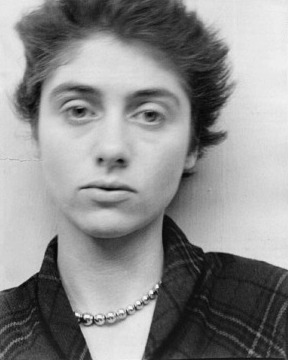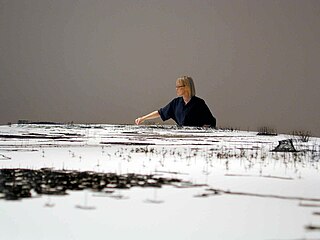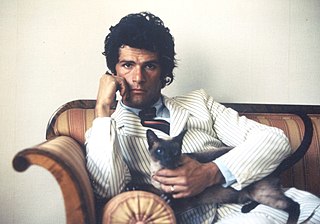
Diane Arbus was an American photographer. She photographed a wide range of subjects including strippers, carnival performers, nudists, people with dwarfism, children, mothers, couples, elderly people, and middle-class families. She photographed her subjects in familiar settings: their homes, on the street, in the workplace, in the park. "She is noted for expanding notions of acceptable subject matter and violates canons of the appropriate distance between photographer and subject. By befriending, not objectifying her subjects, she was able to capture in her work a rare psychological intensity." In his 2003 New York Times Magazine article, "Arbus Reconsidered", Arthur Lubow states, "She was fascinated by people who were visibly creating their own identities—cross-dressers, nudists, sideshow performers, tattooed men, the nouveaux riches, the movie-star fans—and by those who were trapped in a uniform that no longer provided any security or comfort." Michael Kimmelman writes in his review of the exhibition Diane Arbus Revelations, that her work "transformed the art of photography ". Arbus's imagery helped to normalize marginalized groups and highlight the importance of proper representation of all people.
William Eggleston is an American photographer. He is widely credited with increasing recognition for color photography as a legitimate artistic medium. Eggleston's books include William Eggleston's Guide (1976) and The Democratic Forest (1989).
Linda Connor is an American photographer living in San Francisco, California. She is known for her landscape photography.
Jim Goldberg is an American artist and photographer, whose work reflects long-term, in-depth collaborations with neglected, ignored, or otherwise outside-the-mainstream populations.
Ralph Rucci is an American fashion designer and artist. He is known in particular for Chado Ralph Rucci, a luxury clothing and accessories line. Rucci's clothing designs have appeared in a number of major exhibitions, and he has won some significant fashion-industry awards. He is the subject of a recent documentary, and he and his clothing have received positive critical response in the fashion press.

Tatiana Sorokko is a Russian-born American model, fashion journalist, and haute couture collector. She walked the runways for the world's most prominent designers and fashion houses, appeared on covers of leading fashion magazines, and became the first Russian model of the post-Soviet period to gain international recognition. After modeling, Sorokko worked as contributing editor for Vogue, Vanity Fair and Harper's Bazaar. Her distinct personal style and her private collection of historically important haute couture clothing were subjects of museum exhibitions in Russia and the U.S.

Anne Wilson is a Chicago-based visual artist. Wilson creates sculpture, drawings, Internet projects, photography, performance, and DVD stop motion animations employing table linens, bed sheets, human hair, lace, thread and wire. Her work extends the traditional processes of fiber art to other media. Wilson is a professor in the Department of Fiber and Material Studies at The School of the Art Institute of Chicago.
Marco Glaviano is an Italian photographer and architect, who has worked for fashion magazines and brands on both sides of the Atlantic, and with many of the world's best known models. He has been a pioneer of digital photography, being the first to publish a digital picture in American Vogue in 1982. His photographs of fashion, celebrities, landscapes, and jazz have appeared in numerous museums and are in private and public collections worldwide. He is the co-founder of Pier 59 Studios in New York City, which he also helped design.

Jacopo Strada was an Italian polymath courtier, painter, architect, goldsmith, inventor of machines, numismatist, linguist, collector, and merchant of works of art. His portrait by Titian has kept his image familiar.

Isabelle Jeanne Marie Alice Jacobs, by marriage, Countess Isabelle de Borchgrave d'Altena is a prominent Belgian artist and sculptor, best known for her colorful paintings, intricately painted paper sculptures, paper garments and wearable art. She is married to Count Werner de Borchgrave d'Altena.
Jeff Brouws is a documentary photographer who resides in Upstate New York.
Sanaz Mazinani is an Iranian–born Canadian multidisciplinary visual artist, curator and educator, known for her photography and installation art. She is currently based in San Francisco and Toronto.
Anthony Friedkin is an American photographer whose works have chronicled California's landscapes, cities and people. His topics include phenomena such as surf culture, prisons, cinema, and gay culture. Friedkin’s photographs have been exhibited in the Los Angeles County Museum of Art and the J. Paul Getty Museum. His photographs are included in major Museum collections: New York's Museum of Modern Art, The J. Paul Getty Museum and others. He is represented in numerous private collections as well. His pictures have been published in Japan, Russia, Europe, and many Fine Art magazines in America.

Natasha Boas is a French-American contemporary art curator, writer, and critic. She has taught art history and curatorial studies at Yale, Stanford, and the San Francisco Art Institute. Her exhibition on the Modernist Algerian artist, Baya Mahieddine Baya: Woman of Algiers in 2018 at the Grey Art Gallery at New York University garnered her international critical attention. In 2017 she was featured in Lynn Hershman Leeson's Vertighost, playing the role of herself as an art historian. She also authored the Facebook Artist in Residence book on the recent history of Art and Technology in the Bay Area for the 5th anniversary of Facebook's artist-in-residency program. An adjunct professor at the California College of the Arts, she is an expert in the art of California countercultures, the modernist avant-garde, surrealist women artists, the Mission School and Outsider artists.

John P. Jacob is an American curator. He grew up in Italy and Venezuela, graduated from the Collegiate School (1975) in New York City, and studied at the University of Chicago before earning a BA in human ecology from the College of the Atlantic (1981) and an MA in art history from Indiana University (1994).

Victor Arimondi was an Italian American photographer and model who lived and worked in Europe before moving to the United States in the late 1970s. His early fashion photography, his portraits of Grace Jones and other artists, and his male nudes photographed in New York and San Francisco captured the pre-AIDS culture of the 1970s and early 1980s.
Melissa Ann Pinney is an American photographer best known for her closely observed studies of the social lives and emerging identities of American girls and women. Pinney's photographs have won the photographer numerous fellowships and awards, including Guggenheim and NEA Fellowships, and found their way into the collections of the major museums in the US and abroad.
Susan Efay Ciriclio, also known as S.E. Ciriclio, was an American photographer and educator particularly known for her photographic mapping project "Neighborhood".
Sandra S. "Sandy" Phillips is an American writer, and curator working in the field of photography. She is the Curator Emeritus of Photography at the San Francisco Museum of Modern Art. She joined the museum as curator of photography in 1987 and was promoted to senior curator of photography in 1999 in acknowledgement of her considerable contributions to SFMOMA. A photographic historian and former curator at the Vassar College Art Gallery in Poughkeepsie, N.Y., Phillips succeeded Van Deren Coke as head of one of the country’s most active departments of photography. Phillips stepped down from her full time position in 2016.
Root Division is an American arts nonprofit 501(c)(3) organization founded in 2002, and located in the Mid-Market/South of Market neighborhood of San Francisco, California.







